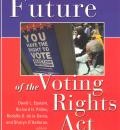If the Supreme Court holds Section 5 of the VRA unconstitutional by the end of this Term, or cuts back substantially on Section 5’s scope, an outpouring of policy and political energy will undoubtedly burst forth to suggest what kind of legislative response, if any, is warranted. One comprehensive collection of recommendations and suggestions already exists about the direction voting rights policy might most effectively take, from leading academic experts in law and political science on the VRA, in this book, The Future of the Voting Rights Act, for which I was one of the editors. Published by the Russell Sage Foundation, the book can be found here.
Ironically, the book was designed to inform the legislative policy process when Section 5 expired in 2007, but Congress moved the process up to 2006. The book originally came out in 2006 but too late to influence that expedited process. If the Court does invalidate or cut back on Section 5, however, this book will provide a comprehensive starting point for ideas about how Congress might most effectively respond to modernize voting rights policy.
Here is the (modified, updated) description of the book that the Russell Sage Foundation originally published:
The Voting Rights Act (VRA) stands among the great achievements of American democracy. In The Future of the Voting Rights Act, Richard Pildes, Rodolfo de la Garza, Sharyn O’Halloran, and others bring together leading historians, political scientists, and legal scholars to assess the role a re-designed Section 5, or other voting rights legislation, should play in America’s future.
The contributors offer varied perspectives on the most effective future for voting rights law and policy. Rodolfo de la Garza and Louis DeSipio explore the VRA’s limited focus thus far on the situation of Hispanic residents and citizens, whose interests with respect to voting rights differ in insufficiently appreciated ways from those of African Americans (Laughlin McDonald explores similar issues with respect to Native American voters). Sharyn O’Halloran and David Epstein provide extensive data showing that white voters are more wiling than in the past to vote for African-American candidates and to forge interracial coalitions that successfully elect African-American candidates. Richard Pildes explores the difficulties of updating policies to protect vulnerable voters designed many decades ago to today’s different circumstances, and asks whether minority voters might be better off if voting rights policy now were to better facilitate the formation of winning political coalitions across racial and ethnic lines, rather than focusing exclusively on the creation of “safe” districts that minority voters can dominate.
Nate Persily suggests approaches that would update Section 5 from within, by re-shaping it to fit current circumstances, and approaches that would abandon Section 5’s regionally-targeted philosophy for more aggressive, nationwide protections of voting rights. Spencer Overton and Michael McDonald grapple with crafting an updated coverage formula that identifies those areas that remain exceptionally problematic with respect to their treatment of minority voters. Heather Gerken seeks to enlist greater citizen participation on how to determine areas of the country that are especially problematic. Samuel Issacharoff questions whether Section 5 remains necessary, citing the now substantial presence of blacks in legislative positions and the increasingly partisan enforcement of the law by the Department of Justice (DOJ). Rick Hasen explores the constitutional issues that will continue to affect the options for congressional action.
Examining the role that Section 5 or alternative legislation might play in maintaining a healthy democracy is vital. Combining historical perspective, legal scholarship, and the insight of the social sciences, The Future of the Voting Rights Act is a crucial read for anyone interested in one of this year’s most important constitutional issues before the Supreme Court, for any policy debates that might follow in the wake of the Court’s decision, and in the future of civil rights in America.
EDITORS: RICHARD H. PILDES is Sudler Family Professor of Constitutional Law at New York University School of Law.
RODOLFO O. DE LA GARZA is faculty fellow in the Department of Political Science and director of the Project on Immigration, Ethnicity, and Race at the Institute for Social and Economic Research and Policy at Columbia University.
SHARYN O’HALLORAN is the George Blumenthal Professor of Politics and professor of international and public affairs at Columbia University.
DAVID L. EPSTEIN was formerly a professor of political science at Columbia University.
CONTRIBUTORS: Rodolfo O. de la Garza, Sharyn O’Halloran, Richard H. Pildes, Stephen Ansolabehere, Thomas Brunell, Bruce E. Cain, Guy-Uriel E. Charles, Louis DeSipio, Luis Fuentes-Rohwer, Heather K. Gerken, Bernard Grofman, Richard L. Hasen, Samuel Issacharoff, Karin MacDonald, Peyton McCrary, Laughlin McDonald, Michael P. McDonald, Spencer Overton, Nathaniel Persily, Christopher Seaman, David L. Epstein and Richard Valelly.
